
Ceratophora is a genus of agamid lizards found in Sri Lanka. The male has a horn on its snout.

Salea is a genus of arboreal, slow-moving, diurnal, insectivorous, egg-laying agamid lizards endemic to the Western Ghats of South India. It has two species, each inhabiting very high mountainous tracts of the Western Ghats in the Shola forest ecosystems.

Bronchocela jubata, commonly known as the maned forest lizard, is a species of agamid lizard found mainly in Indonesia on the islands of Singkep, Java, Bali, Sulawesi, Karakelang, Salibabu; Nias Island, Singkap Island, Borneo (Kalimantan) also in Thailand, Cambodia and Philippines. Although in the past it was thought the species may be found in India, either on the mainland or in the Nicobars, this is not the case according to herpetologist Das. It is also known by the common name of "bloodsucker", although this is a misnomer.

Calotes calotes, the common green forest lizard, is an agamid lizard found in the forests of the Western Ghats and the Shevaroy Hills in India, and Sri Lanka.
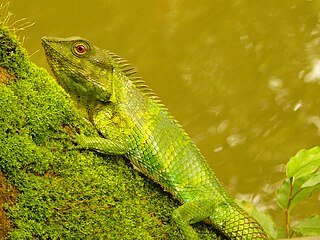
Calotes nemoricola, the Nilgiri forest lizard, is an agamid lizard found in the Western Ghats of India.

Draco maculatus, commonly known as the spotted flying dragon or spotted gliding lizard, is a species of agamid flying lizard endemic to Southeast Asia. It is capable of gliding from tree to tree.
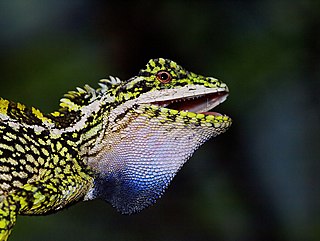
The variegated mountain lizard or Himalayan dragon is an agamid lizard found in northern India, Bhutan, and Nepal.

The Caucasian agama is a species of agamid lizard found in the Caucasus, E/S Georgia, Armenia, Azerbaijan, Turkmenistan, Tajikistan, Dagestan (Russia), E Turkey, Iraq, N Iran, Afghanistan, NW Pakistan, and parts of Kashmir.

Laudakia tuberculata is a species of agamid lizard found in northern Pakistan, northern India, Nepal, eastern Afghanistan, and western China.
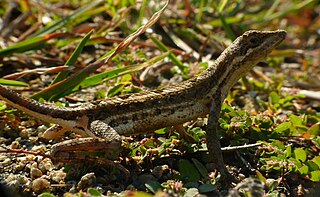
The Pondichéry fan-throated lizard is a species of agamid lizard found in eastern peninsular India. It was earlier thought to be widespread but studies in 2016 resulted in the splitting of the group into several species placed in two genera. The genus Sitana has an enlarged projecting scale on the posterior side of the hind thigh which is absent in the sister genus Sarada.

Dendrelaphis bifrenalis, also called Boulenger's bronzeback, Boulenger's bronze-back, and Travancore bronze-brown snake, is a colubrid snake native to southern India and Sri Lanka. It was first described by George Albert Boulenger in 1890. Dendrelaphis wickrorum from Sri Lanka was previously confused with this species.
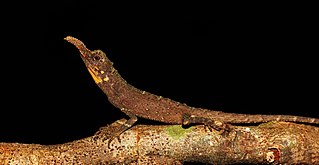
The rough-nosed horned lizard or Sri Lanka horned agama is an Agamid lizard from Sri Lanka in lowland dipterocarp forests and secondary forests in the wet zone. It is distinguished from all the other Ceratophora species by the presence of a complex rostral appendage, comprising more scales than rostral scale alone. The lateral body scales are small and more or less regular shape.

Calotes nigrilabris, the black-cheek lizard, is an agamid species endemic to Sri Lanka. It can be distinguished easily from painted-lipped lizard by having black bar on mouth rather than white or orange bar.
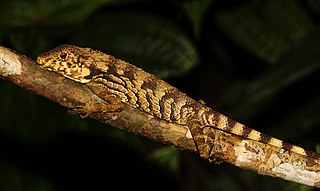
Ceratophora erdeleni, also known as Erdelen's horned lizard or Erdelen's horn lizard, is a species of lizard in the family Agamidae. The species is endemic to Sri Lanka. It has only a rudimentary "horn", that is occasionally missing altogether.
Ceratophora karu, also known as Karu's horned lizard or Karu's horn lizard, is a species of lizard in the family Agamidae. The species is endemic to Sri Lanka.
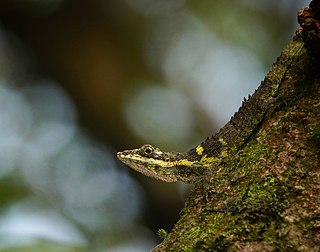
Cophotis dumbara, the Dumbara agama, is an agamid species endemic to Sri Lanka. Known only from Knuckles Mountain Range. It is classified as a critically endangered species due to habitat loss and logging.
Calotes desilvai, commonly known as the Morningside lizard, or the Ceylon black-band whistling lizard, is a species of lizard in the family Agamidae. Calotes desilvai is one of seven Calotes species endemic to Sri Lanka.
Cnemaspis scalpensis, commonly called Ferguson's day gecko or the rocky day gecko, is a species of diurnal gecko. The species is found only in Sri Lanka.
Lankascincus taylori, commonly known as Taylor's tree skink, is a species of lizard in the family Scincidae. The species is endemic to the island of Sri Lanka.
Calotes manamendrai is an agamid lizard endemic to Sri Lanka. Locally known as මනමේන්ද්ර-ආරච්චිගේ උරුවන් කටුස්සා.




















